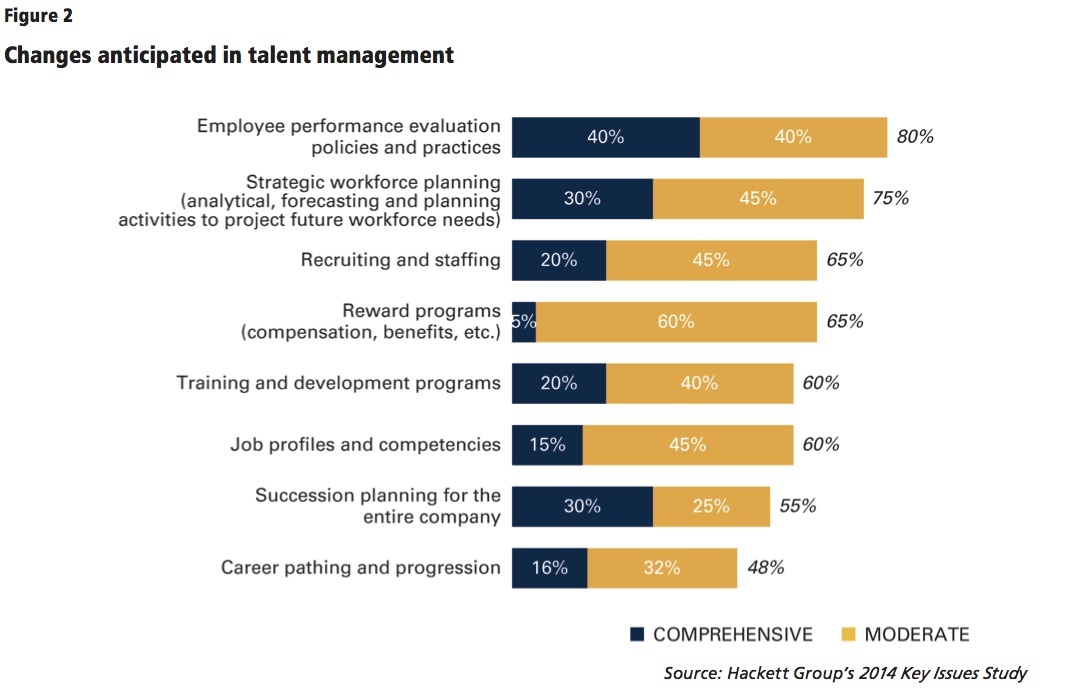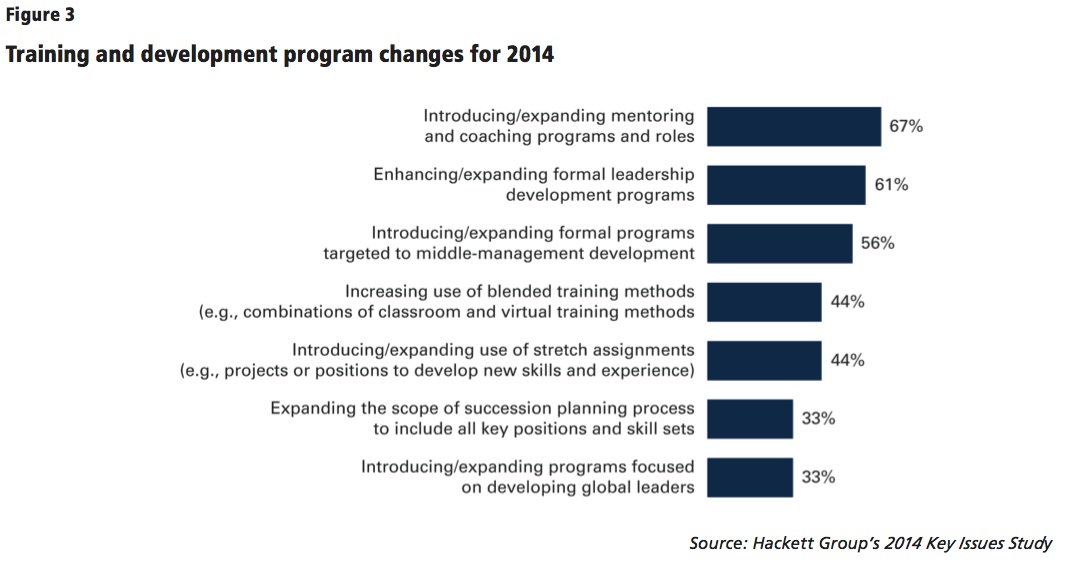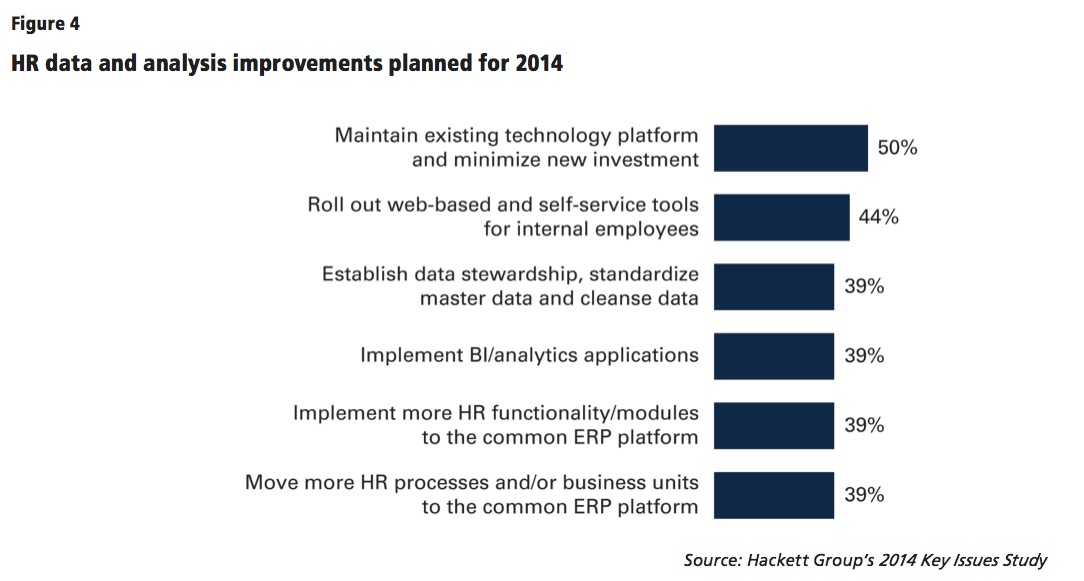
By Natalie Bression, Harry Osle, and Lynne Schneider
The pressure is mounting on HR to change the balance of the services it offers while keeping costs and headcount in check. The Hackett Group’s 2014 Key Issues Study reflects how HR organizations are attempting to successfully shift their service mix and the required enabling capabilities.
HR must not let attention slip from integrated talent management and helping to use those processes to further the goals of the business as a whole. Key priorities for the coming year include:
- Creating and enhancing partnerships with internal business customers
- Effectively managing talent
- Building the skills required to obtain maximum value from data
The business environment continues to be characterized by high levels of volatility and risk. At the enterprise level, demand volatility has been a recurring theme since the 2008 financial crisis and remains the number-one driver
of business strategy. However, other sources of risk and volatility are becoming more prominent. These are related to competition, regulation, and talent. Furthermore, the lingering risk of the global economic crisis is still factored into business strategies by 62 percent of companies participating in our 2014 Key Issues Study.
Despite this persistent uncertainty about business conditions, most companies have reverted to their traditional focus on creating value for shareholders through revenue growth and margin improvement. Over half of companies cite revenue growth as their top financial objective in 2014; 25 percent indicate margin improvement is their main goal. Only 10 percent are principally concerned with simply maintaining revenue levels, and just 3 percent with protecting margin. Significantly, only 4 percent of companies are actually targeting the acceleration of their historical revenue growth rate in the coming year. This very low number indicates a great amount of lingering caution and conservatism in business strategies.
This conservatism in growth strategies becomes more evident when we look at the business strategies deployed to realize the coming year’s financial objectives. Sustainable, innovation-based strategies are top ranked, but only to maintain historical growth rates. Historically, innovation has been associated with a growth-acceleration strategy. In the current environment, innovation is a prerequisite to merely maintaining historical growth grates, staying competitive, and ultimately remaining commercially viable. Improving innovative capacity just to support a very conservative growth strategy (or indeed, a survival strategy) represents a break with the past.
For many, the need to implement sustainable, innovation- based growth strategies requires cultural change in every aspect of operations. Companies are extending their efforts to grow globally, as reflected in the high priority that study participants give to expanding the customer base. Globalization, too, brings its own cultural challenges. Not surprisingly, then, finding or developing the right talent remains one of the main challenges faced by companies.
Reinventing HR to Support Growth
The ultimate measure of the performance of HR organizations is their ability to support the business strategy. Since many of those strategies center on sustainable, innovation-based growth and global expansion, HR needs
to change accordingly. Supporting enterprise goals in 2014 will require some HR organizations to make far more than incremental changes.
The majority of companies are pursuing changes in cost structure. This gap continues a trend that has been unbroken since the 2008 recession.
In 2014, HR will continue to focus on high-value-added programs, and on reducing effort and costs for routine transactions. Increasing the level of business partnering and the sophistication of integrated talent management will also help HR demonstrate how it further enables the business to meet its strategic goals.
No Budget Relief in Sight
Demand for HR services remains high, but on average HR budgets and staffing will shrink in 2014. The report finds that staff is slated to decrease at more than twice the rate of the budget. While this does not mean increased spending on an absolute basis, many HR functions will be able to apply the per full-time employee spending difference toward enhanced technology. This may help offset loss of headcount, and increase the pay for the retained, higher- skilled HR staff.
There is some variation in outlook for different companies, with 48 percent of HR organizations forecasting a budget increase for 2014, and only 26 percent projecting an increase in staff. This will be a year of altering the way that money and staff will be aligned to enable HR to deliver higher-value services while keeping costs relatively flat.
Top Priorities for HR
HR’s strategic agenda for the coming year includes business partnership, talent management, and continuing to upgrade the use of technology and information (see Figure 1 on page 49). All of these elements work toward a reinvention of HR and are consistent with the key issues that Hackett sees across the business services landscape:
1. Developing and strengthening business partnerships. Much of HR’s effort in 2014 will be devoted to the difficult task of enhancing the HR/business partnership. This can only
happen when HR leaders and staff begin to think and speak in terms that the business cares about and understands. At that point, HR will have the political and intellectual capital to become a full member of the strategy-setting team, applying its knowledge of human capital to the business strategy.
2. Raising the level of talent-management expertise. HR professionals have long prided themselves on being able to enhance the value of the human capital within the company where they work, adding to productivity through training, performance management, and good employee relations. Now, the call is to do more and prove the value of talent management empirically.
Most aspects of talent management will undergo significant changes over the next year or so. Across the entire company, plans are in place to make important alterations to performance management and strategic workforce planning in particular (see Figure 2). Hackett research has found that companies are not getting a return commensurate with the effort being put into performance management. Therefore, HR is looking for ways to change this process and add value for both individuals and the business as a whole.
It is also worth noting that 30 percent of companies anticipate a comprehensive change to their succession planning programs. For some, this will be the starting point for their overall strategic workforce plan; for others, this reflects a redoubling of efforts to ensure that the next generation of leadership is in place. Lack of a succession plan is a major talent risk. However, focusing solely on top leadership is also a significant risk. Given macro-level trends such as demographic changes in the workforce and increasing globalization of work, companies need to broaden their workforce planning endeavors.
Within training and development areas, the hub of activity is changing too. Companies have been moving away from formal, classroom-based training for some time due to a lack of funding and growing evidence that this format is not appropriate for the development of many essential skills. Coaching and mentoring programs will be in the spotlight this year (see Figure 3). The 2014 Key Issues Study also shows a renewed emphasis on formal leadership—development programs and expansion of similar programs for middle managers. This is connected to the aim of putting more thought into formal succession plans.
Given improving economic conditions globally, the recruiting market is expected to become even more competitive and retention programs will return to the fore. Companies are using improved employee data to facilitate increased rates of internal placements for open positions. This is occurring both in a proactive sense—to respond to employees’ desires to tackle new challenges—and in a reactive sense, with internal recruiters able to identify qualified talent already inside the company.
3. Improving the utility of technology and data. Recent Hackett research found that low-quality data is an inhibitor to more effective strategic workforce planning processes.
It is also the primary obstacle to strengthening operational planning and analysis capabilities. HR needs to make the most of the data it has, as well as gather more data in areas where it has not done so previously, such as employee competencies and external labor-market trends.
Technology priorities for 2014 are heavily weighted toward making the most of existing investments. Companies are minimizing new technology purchases and seeking to roll out web-based and self-service options. Efforts planned to gain mastery over data will enable self-service and business- intelligence tool usage. But it will be necessary to be able to work cooperatively with the IT and operations departments, for example to marry employee data with indicators of productivity.
Improved data quality will also allow HR to meet other goals for measuring its performance and better integrating its planning and analysis activities with those of the rest
of the business. This has an analytical skills component, which HR must continue to develop. Once good data becomes available, the HR team must have the expertise
to do something with it. In our recent research on strategic workforce planning, 46 percent of respondents agreed or strongly agreed that at present, the HR group is largely lacking in these skills. Recognizing this weakness, more than half of HR functions are planning initiatives in 2014 to improve their data analysis capabilities (see Figure 4).
HR is also changing the way it captures data about its own performance and shares it with other parts of the enterprise. While overall costs and turnover rates have been used extensively in the past, HR functions are looking increasingly toward return-on-investment (ROI)-based metrics to gauge and communicate their success. For many years, the business has needed better data about the return on its investments in areas such as training and development. Now, HR is close to cracking to code on how to quantify these returns.
Also on the horizon is an increased focus on productivity measurement across disparate functions and industries. This will lead to HR being able to realign resources to the activities and services that provide the best return on budget dollars and staff time invested. All of these data and technology-related initiatives will bring HR into closer partnership with the business, highlighting HR’s value contribution. When ROI can be clearly illustrated, better strategic discussions will follow about where to make investments in HR programs.
Strategic Implications
HR needs to continue developing a business-focused orientation, realigning resources as needed to support the achievement of business goals. There is no room in budgets or staffing plans to add this functionality, so it must be achieved by changing the way that services are delivered.
For business executives to think of HR as a value-adding business partner, HR must demonstrate integrated
talent management practices. These need to take into consideration both the employee life cycle and the changing talent needs of the businesses in which this talent is currently deployed. Better data is a required foundation for achieving a more thorough understanding of the talent in place today and what is needed to deliver on future strategies. And, the integration of business planning data along with employment market data will help HR identify and act on early warnings about risks.
Nathalie Bression is practice leader of human resources executive advisory program; Harry Osle is principal in charge of global human resources transformation and advisory services; and Lynne Schneider is senior research director for The Hackett Group.


















